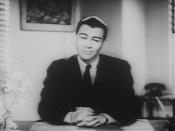In "Life in the Iron Mills" Rebecca Harding Davis reveals a growing industrial America in the nineteenth century, where an unbelievable level of poverty and limited opportunities of achieving success can cause individuals to take extreme risks to attain a descent lifestyle. Through the novella, Davis illustrates the distinct differences between upper and lower class lifestyles. Immigrant workers, Debora (lovingly called Deb) and Hugh, take the reader to a time when people were used as production machines and poverty was a state into which most people were fated to be born and die. By using techniques such as strong language and symbolism, a narrator who helps create a sympathetic bias towards the working class and an innocent character who the reader is aware of to be pre-destined to doom, Davis illustrated the harsh realities of urban industrialization and made the reader sympathize with the lower class and their ways of survival.
Davis begins the novella with an outline and description of the period and environment, dirty, unhealthy, and not very fair. The narrator then goes on to tell the story of a particular worker, Hugh Wolfe. Wolfe worked at a steel mill, and never got hurt before and was a very reliable worker, yet he still got paid extremely low salaries. One day his cousin, Deb Wolfe, goes to the Iron Mill to give Hugh his meal, she feels very drowsy and decides to rest before returning home. Her husband is at the same time making his "masterpiece," the hungry lady, right when the mill owners, followed by other friends take a tour of the factory. They see the statue and decide to comment Wolfe on it. Deb hears them speaking and conversation take a turn when the doctor says he is a good artist and art could...


